|
DID
YOU KNOW.....
FLOODLIGHTS
Football has a million
and one stories and just as many facts and figures. Here are a few of them
- the record-breaking, unusual and bizarre. More
Did You Knows...
Index
1 2
3 4
5 6 7
8 9
10 11
12 13
14 15
16 17
18 19
20
21
22 23
24 25
26 27
28 29
30 31
32 33
34
The first football match ever played
under floodlights took place at Bramall Lane, Sheffield, on Monday 14 October 1878
between two local representative sides. It was a great success with 12,000
paying to enter to witness the spectacle and probably another 8,000
sneaking in under the cover of darkness. Two 8-horsepower generators
behind each goal powered floodlights mounted on 30ft towers located in
each of the corners. Only the pitch was lit and not the entrances which
explains why so many were able to get in without paying. The crowd was a
record for a football match in England - by contrast the FA Cup final
played a few months earlier had an attendance of only 4500.
*********
Despite the success of that match
the lack of any official encouragement meant floodlit football was limited
to exhibition fixtures. The first floodlit match that is believed to have
had any official sanctioning was played at Mansfield's Field Mill ground
on Saturday 22nd February 1930. But it was not one of the major fixtures
of the footballing calendar - Ollerton Forest v Welbeck Athletic in the
final of the North Nottinghamshire Senior Cup. However in August 1930 the
FA banned floodlit football, even rebuking Watford for switching on the trackside lighting used for greyhound racing during a match in
December 1930.
*********
 The FA ban remained in place until
December 1950 although a month later they added a qualifying clause which
stated that no competitive match could be played under lights without
permission of the FA or the County FA and the organisers of the competition.
But clubs began to see the importance of floodlights. Swindon Town became
the first League side to install floodlights - their first match a
friendly against Bristol City on Monday 2nd April 1951. Arsenal soon The FA ban remained in place until
December 1950 although a month later they added a qualifying clause which
stated that no competitive match could be played under lights without
permission of the FA or the County FA and the organisers of the competition.
But clubs began to see the importance of floodlights. Swindon Town became
the first League side to install floodlights - their first match a
friendly against Bristol City on Monday 2nd April 1951. Arsenal soon
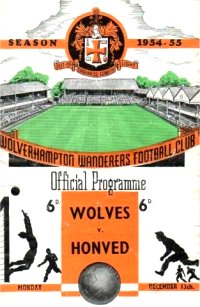 followed with the first match under the Highbury lights taking place on
Wednesday 19th September 1951 when 40,000 attended a friendly against Hapoel Tel Aviv. But it was Wolves, who switched their lights on in a
friendly against South Africa on Wednesday 30th September 1953, who did
the most to further the cause. Friendlies against clubs such as Honved,
Moscow Spartak and Moscow Dynamo were to show that the paying public had
an appetite for floodlit football and for fixtures against top-class
foreign opposition. European competitive football was not far away.
followed with the first match under the Highbury lights taking place on
Wednesday 19th September 1951 when 40,000 attended a friendly against Hapoel Tel Aviv. But it was Wolves, who switched their lights on in a
friendly against South Africa on Wednesday 30th September 1953, who did
the most to further the cause. Friendlies against clubs such as Honved,
Moscow Spartak and Moscow Dynamo were to show that the paying public had
an appetite for floodlit football and for fixtures against top-class
foreign opposition. European competitive football was not far away.
*********
Following the lifting of the FA ban
the first competitive fixture played under floodlights was at the Dell on Monday 1st October 1951 when Southampton Reserves played Spurs Reserves
in the Football Combination.
The first FA Cup tie to be played under
floodlights was a Preliminary Round replay between Kidderminster Harriers
and Brierley Hill Alliance played on 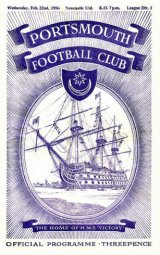 Wednesday 14th September 1955. Wednesday 14th September 1955.
Two months later the first FA Cup
match involving League sides was played at St James' Park, Newcastle, on
Monday November 28th 1955 when Carlisle United met Darlington in the
second replay of a First Round tie
(results).
It wasn't until
the League AGM in
June 1955 that the Football League changed its rules to allow League
matches to be played under lights, the first such match being at Fratton
Park on Wednesday 22nd February 1956 when Portsmouth entertained Newcastle
in a First Division fixture.
*********
The last club to play in
the Football League without floodlights were Chesterfield. The Spireites
finally switched on their lights in a friendly against Sheffield Wednesday
on Wednesday 18th October 1967. The last club to play in the top flight
without floodlights was Fulham who played their first floodlit match at
Craven Cottage on Wednesday September 19th 1962 when defeating Sheffield
Wednesday 4-1 in a First Division encounter.
*********
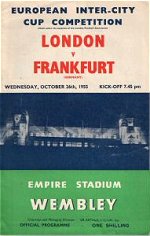 Considering that it is our national
Stadium, Wembley was a tad slow to adopt
floodlighting. They were installed at a cost of £22,000 with the first
match under floodlights being an Inter-Cities Fairs Cup match between
London and Frankfurt on Wednesday October 26th 1955
(results). Considering that it is our national
Stadium, Wembley was a tad slow to adopt
floodlighting. They were installed at a cost of £22,000 with the first
match under floodlights being an Inter-Cities Fairs Cup match between
London and Frankfurt on Wednesday October 26th 1955
(results).
England played under the Wembley lights for the first time for the final
15 minutes of their friendly against Spain on Wednesday November 30th
1955. Amazingly England didn't play a full 90 minutes under the Wembley
floodlights until they played Northern Ireland in a Home International
match on Wednesday November 20th 1963, which England won 8-3.
England's first match under floodlights though wasn't at Wembley but in
the US of A on Monday 8th June 1953 at New York's Yankee Stadium. Two
goals apiece from Tom Finney and Nat Lofthouse helped England to a 6-3
victory over the United States.
*********
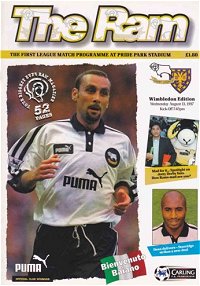 Derby County's
programme cover for the Premier League match against Wimbledon on
Wednesday August 13th 1997 proudly announced that it was the first League
match at their newly-opened Pride Park ground. But pride turned to
embarrassment when the floodlights failed after 11 minutes of the second
half when Wimbledon were leading 2-1. Ref Uriah Rennie abandoned the
match half an hour later after attempts to resolve the problem proved
unsuccessful. Derby Vice-Chairman
Peter Gadsby said: 'We had 11 maintenance people on duty including six
electricians but nobody has yet worked out why both generators failed.
There was a bang of such strength that it fused them both.' Derby County's
programme cover for the Premier League match against Wimbledon on
Wednesday August 13th 1997 proudly announced that it was the first League
match at their newly-opened Pride Park ground. But pride turned to
embarrassment when the floodlights failed after 11 minutes of the second
half when Wimbledon were leading 2-1. Ref Uriah Rennie abandoned the
match half an hour later after attempts to resolve the problem proved
unsuccessful. Derby Vice-Chairman
Peter Gadsby said: 'We had 11 maintenance people on duty including six
electricians but nobody has yet worked out why both generators failed.
There was a bang of such strength that it fused them both.'
Three months later, on
November 3rd 1997, another Premier match suffered an abandonment because
of floodlight failure. The Monday night televised match between West Ham
and Crystal Palace went dark immediately after Frank Lampard's 65th minute
goal for the Hammers which had made the score 2-2. Again attempts to
restart the match failed and ref David Elleray was forced to abandon the
fixture. West Ham managing director Peter Storrie said 'The
floodlights at the south end contracted a fault which was impossible to
find in the timescale. As this end controls the floodlights for both ends
of the ground, this is why the whole system went down.'
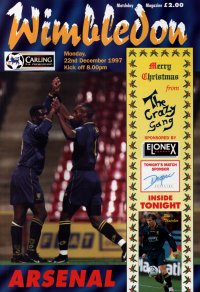 Amazingly the
following month the same happened again. At Selhurst Park on Monday
December 22nd 1997 a failure of the switch gear controlling the ground's
power supply seconds into the second half of the Premier League match
between Wimbledon and Arsenal caused a blackout. Engineers managed to
briefly restore power but the supply failed again before play restarted
forcing ref Dermot Gallagher to abandon the televised match with the score
0-0. Amazingly the
following month the same happened again. At Selhurst Park on Monday
December 22nd 1997 a failure of the switch gear controlling the ground's
power supply seconds into the second half of the Premier League match
between Wimbledon and Arsenal caused a blackout. Engineers managed to
briefly restore power but the supply failed again before play restarted
forcing ref Dermot Gallagher to abandon the televised match with the score
0-0.
Wimbledon owner Sam
Hammam commented on the three abandonments 'This shouldn't be
happening. Once was bad enough, the second wasn't pretty, and this is
getting near a disaster. Unless we stop it there will be shame on the
game. We are all embarrassed by it.' Foul play was suspected but
police could find no evidence of wrong-doing. Until February of 1999 that
is.
Police were made aware
of an attempt to install a remote control device which would have
interfered with the floodlights at the Charlton v Liverpool Premier League
match at the Valley on February 13th 1999. An investigation concluded that
a Malaysian-betting syndicate was behind the floodlight failures at West
Ham and Wimbledon and the incident at Charlton - but could find no link
with the problem at Pride Park. Betting on Premier League matches is big
business in Asia and unlike in Britain, where bets on the result of an
abandoned match are void, in Asia the score stands in matches that survive
to the second half before being abandoned. So there was a potential profit
of millions of pounds if a match could be ended in the second half when
there was a favourable scoreline for floodlight saboteurs. Wai Yuen Liu,
Eng Hwa Lim and Chee Kew Ong plus Charlton security supervisor Roger Firth
were all found guilty of conspiracy to cause a public nuisance and jailed.
And from then on floodlights became a bit more reliable!
*********
Huddersfield Town left
it late to install floodlights at their old Leeds Road ground and it was
only after they sold Denis Law to Manchester City in 1960 for a then
British record transfer fee of £55,000 that they decided to invest some of
that fee in floodlighting. Their first match under lights was an FA Cup
Cup 3rd Round replay against Wolves on January 11th 1961 but a little over
a year later - in February 1962 - a gale blew down two of the pylons with
one landing on the pitch.
*********
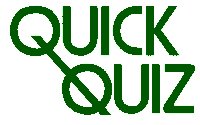 |
Question:
Which former
Football League ground had three traditional floodlight pylons and
then this one, attached to the top of a stand?
Click for answer |
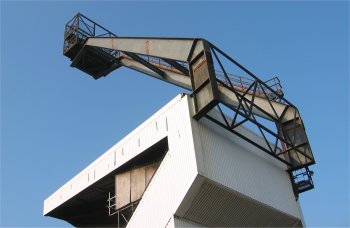 |
*********
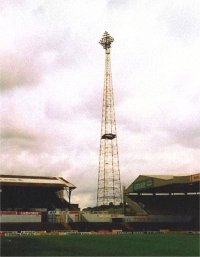 There
was a time when finding a football ground was straightforward
enough - four floodlight pylons made navigation very easy. The easiest
ground of them all to find was the Elland Road home of Leeds United.
Because of the various Leeds stands the pylons were built outside the
ground and so each had to be nearly 260 feet tall - the tallest in the
League and reputedly the tallest in Europe
(pictured). They came down after the East Stand was opened in 1993 which
had - as in most modern grounds - floodlights along the roof of the
stands. I'm sure its no coincidence that sat-navs needed to be invented when when we started losing floodlight pylons! There
was a time when finding a football ground was straightforward
enough - four floodlight pylons made navigation very easy. The easiest
ground of them all to find was the Elland Road home of Leeds United.
Because of the various Leeds stands the pylons were built outside the
ground and so each had to be nearly 260 feet tall - the tallest in the
League and reputedly the tallest in Europe
(pictured). They came down after the East Stand was opened in 1993 which
had - as in most modern grounds - floodlights along the roof of the
stands. I'm sure its no coincidence that sat-navs needed to be invented when when we started losing floodlight pylons!
*********
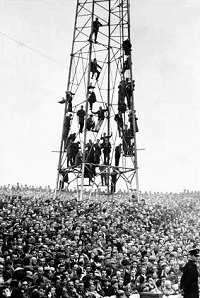
Floodlight pylons weren't just
useful for navigation but as these Cardiff City fans at Ninian Park in
1961 show they were also a useful platform for watching the match.
Obviously long before 'Health and Safety' was invented!
*********
When Cheltenham Town, then in the
Southern League, installed floodlights at their Whaddon Road ground in the
early 1950's their neighbours weren't too chuffed. When the floodlights
were switched on all the houses in the area of the ground lost power! And
it wasn't because the ground was brilliantly illuminated. The lights were
only 20 feet or so from the ground so every time the ball was kicked
higher from that it disappeared from view with players having to
anticipate where it would reappear!
*********
The Manchester United
junior sides were playing floodlit matches at the club's Cliff training
ground long before floodlights were installed at Old Trafford. Such was
the novelty of those floodlit matches a vital clue was given in the
programme as to how it could be read after the evening darkness had
descended - 'To read - hold programme to light'. Now we
know!
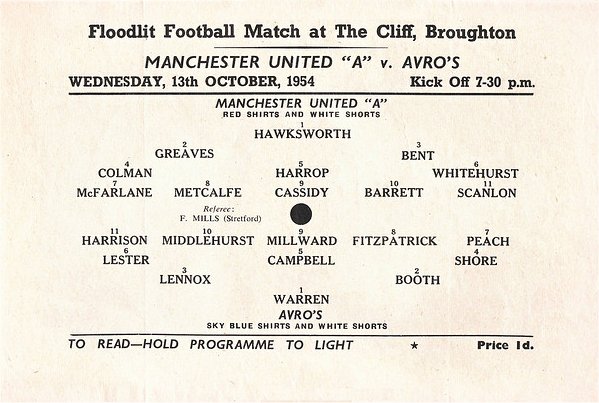
|